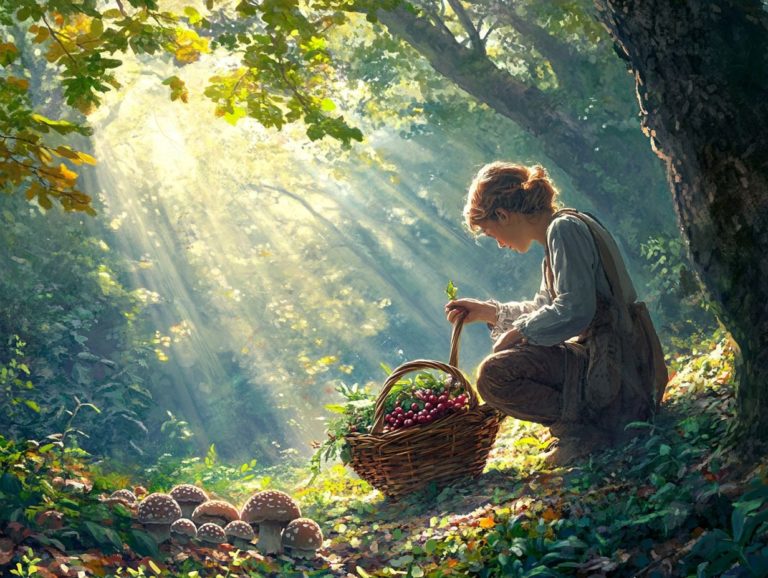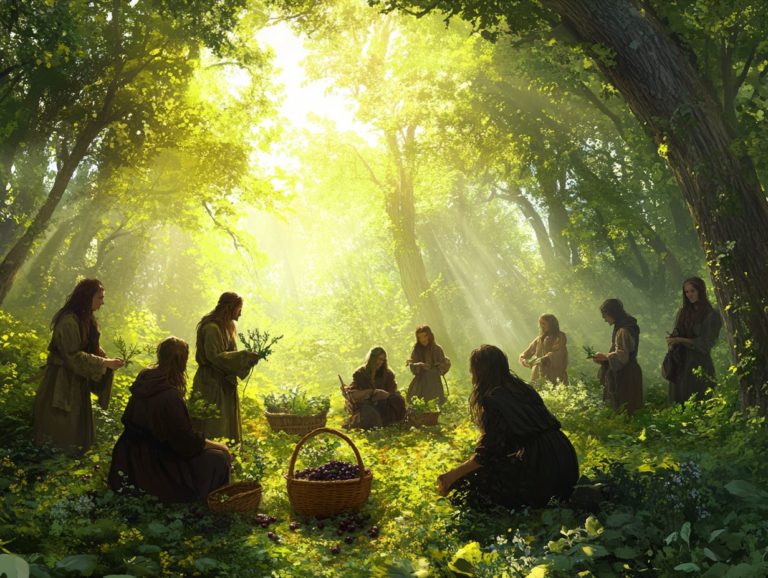The Future of Foraging: Trends in Sustainability
Foraging is the art of gathering wild food. This practice is making a comeback as people seek a deeper connection to nature and commit to sustainable living.
We will explore the latest trends in foraging. This includes popular practices and lively discussions about reconnecting with our natural surroundings.
Learn how you can work with communities and policymakers to support responsible foraging. Together, we can protect our environment and promote conservation.
Contents
- Key Takeaways:
- Current Trends in Foraging
- The Future of Foraging
- Promoting Sustainable Foraging
- Frequently Asked Questions
- What is foraging and why is it important?
- What are the current trends in foraging sustainability?
- How does foraging impact the environment?
- What role does technology play in the future of foraging sustainability?
- How Can Individuals Help Keep Foraging Sustainable?
- What Are the Possible Good Things About Foraging for Our Future?
Key Takeaways:

- Foraging impacts the environment positively and negatively.
- Current trends in foraging highlight both popular practices and controversies.
- Technological advancements and community actions can shape the future of sustainable foraging.
Defining Foraging and Its Impact
Foraging is about harvesting wild food like plants and mushrooms. It connects you to nature and helps sustain local ecosystems.
Understanding the environmental impacts of foraging is key to promoting biodiversity. This is vital as we face challenges like climate change and species extinction.
Foraging has historically supported human survival. This ancient practice can promote ecological advantages and preserve diverse plant and animal life.
Learning about native species helps conservation efforts. By doing this, you contribute to maintaining healthy ecosystems.
Engaging in foraging encourages sustainable practices. You can reduce reliance on industrial agriculture and support environmental stewardship.
Current Trends in Foraging
Foraging is gaining popularity, especially in urban areas. Communities are focusing more on sustainable food systems and learning about using technology for sustainable foraging to revive indigenous practices.
This trend shows a growing awareness of where food comes from. It also highlights the ecological impacts of industrial farming.
By exploring foraging, you deepen your connection to the environment. You play a vital role in fostering health, diversity, and sustainability in your community.
Popular Foraging Practices
Among the various popular foraging practices, you often find yourself drawn to accessible species like garlic mustard, wild leeks, and black walnuts. These species beautifully showcase nature’s diverse bounty. Harvesting these wild foods offers not just nutritious options but also helps you connect with nature.
As you explore local woodlands and meadows, you often share tips with fellow enthusiasts on how to recognize edible plants and fungi, making foraging a fun group activity. The rich, nutty flavor of wild leeks and the tangy zest of garlic mustard can elevate your home-cooked meals, cultivating that delightful farm-to-table mindset.
The thrill of discovering sought-after mushrooms, such as chanterelles or morels, adds an exciting layer of connection to the land. This practice nurtures your well-being and instills a sense of responsibility toward preserving natural habitats. It also helps mitigate the impacts of urbanization, demonstrating how foraging allows communities to thrive in harmony with nature.
Controversies and Concerns

Foraging, while brimming with benefits, is not without its share of controversies and concerns. This includes issues related to the sustainability of wild resource harvesting and the role of education in sustainable foraging, along with their implications within capitalist systems. Urbanization and the risk of overharvesting can have detrimental effects on biodiversity, sometimes even leading to species extinction and the degradation of natural ecosystems, especially in human-dominated habitats.
We must act now to address these challenges to ensure that foraging practices remain environmentally responsible and beneficial for marginalized communities grappling with poverty and food insecurity. Education on sustainable practices is essential.
The influence of capitalism where private owners control trade and industry often turns natural resources into commodities. This can tempt consumers to exploit wild areas without a thought for ecological balance, reinforcing issues of food security. Commercialization can lead foragers to take more than what is sustainable, risking the very resources they depend on for their livelihoods.
Socio-economic factors play a significant role here. Communities lacking access to education and resources may not engage in responsible foraging practices that support conservation. It’s imperative to foster a deeper understanding of the connections between ethical foraging, environmental conservation, and social equity, particularly for indigenous communities. This ensures that the wild bounty can be enjoyed by generations to come.
The Future of Foraging
The future of foraging is set to undergo a remarkable transformation. This transformation is driven by technological advancements and the rise of food forests that enhance both accessibility and sustainability in wild food harvesting. As you deepen your understanding of foraging practices through educational platforms, community workshops, and top resources for sustainable foraging, you’ll discover the potential for integrating technology to make responsible harvesting decisions.
This innovative approach not only strengthens your connection to nature but also redefines foraging itself. It elevates foraging to a crucial role within sustainable food systems. Embracing this mindset positions foraging as an essential practice for the future, blending tradition with modernity as highlighted in the growing popularity of foraging techniques for a more harmonious relationship with the environment.
Join us in embracing responsible foraging practices to ensure a sustainable future!
Technological Advancements and Innovations
Technological advancements, especially through mobile applications, GPS mapping, and tools that help you identify edible plants, have transformed your foraging experience. You can now safely track harvesting locations and identify plants like garlic mustard, wild leeks, and black walnuts.
These innovations streamline foraging practices and promote sustainable harvesting by informing you about the ecological impact of your activities and their role in supporting healthy ecosystems.
As technology evolves, it opens new opportunities for responsible engagement with nature while preserving the variety of plants and animals.
Many apps feature community-driven platforms that allow you to share experiences, tips, and map sustainable foraging spots. By creating a collaborative environment, these tools empower you to deepen your understanding of local ecosystems and contribute to conservation efforts that benefit both communities and nature.
For example, features highlighting seasonal growth patterns or indicating areas facing overharvesting can enhance your awareness and responsibility as a forager.
In this way, technology acts as a bridge, connecting you with traditional foraging practices and enriching your appreciation of nature while ensuring its future.
Potential Solutions for Sustainable Foraging
To achieve sustainable foraging, focus on enhancing community education about responsible harvesting and promoting conservation efforts for local ecosystems, particularly native plant species. Understanding the role of community in sustainable foraging is crucial to develop strategies that balance foraging with ecological preservation.
Education initiatives empower you to make informed choices that benefit your health and the environment.
Community workshops serve as vital platforms for sharing experiences and knowledge about sustainable techniques and maintaining soil health. Conservation programs emphasize protecting native plant species and habitats, ensuring that foraging does not deplete local resources or disrupt wildlife.
Providing educational resources, like online guides and mobile apps, enhances awareness and accessibility, allowing you to forage in ways that respect nature. These combined efforts promote ecological integrity and foster a shared sense of community responsibility toward the environment and social equity.
Promoting Sustainable Foraging

Promoting sustainable foraging requires a nuanced approach that combines individual efforts with community initiatives and strong government policies focused on environmental conservation. Engage in responsible foraging practices that protect biodiversity and participate in community activities that educate and raise awareness about local ecosystems.
Effective policy measures can create frameworks that support sustainable practices and ensure wild resources are harvested in ways that maintain ecological integrity.
Individual and Community Actions
You and your community play a crucial role in promoting sustainable foraging. Engage in educational initiatives and adopt responsible harvesting practices that protect biodiversity. You can deepen your foraging knowledge through workshops and local groups.
Communities can organize events that foster collective learning and stewardship of natural resources. This cooperative approach cultivates a sense of responsibility towards the environment and strengthens community bonds. It ensures that foraging practices remain sustainable.
By creating opportunities for hands-on experiences, like guided foraging walks, you can learn to identify edible plants and appreciate their ecological significance. Establishing forums for sharing experiences and tips helps build a strong support network among foragers, encouraging sustainable habits.
Local organizations can also harness social media to spread information about seasonal foraging, safe harvesting techniques, and conservation efforts.
By emphasizing the importance of respectful and mindful foraging, you and your community can collaborate to maintain the delicate balance of local ecosystems. This ensures that future generations will continue to enjoy the natural bounty.
Government and Policy Involvement
Government actions shape the future of foraging. It is essential to establish rules necessary to protect biodiversity and bolster conservation efforts. Policymakers can set forth guidelines governing foraging activities, ensuring these practices remain ecologically responsible.
They can also provide educational resources to elevate public awareness and understanding. This synergy between government and communities paves the way for a sustainable approach to harvesting wild resources.
By focusing on effective legislation, authorities can identify the quantities and locations suitable for foraging. This effectively prevents overharvesting that jeopardizes both plant and animal populations. Initiatives aimed at educating the public about local ecosystems can deepen your appreciation for biodiversity, illuminating the delicate balance that exists within nature.
Such programs champion responsible practices and galvanize community involvement in conservation efforts. The collaboration between government agencies and local foragers fosters a culture of sustainability that prioritizes ecological health.
Ultimately, this ensures that future generations can relish the gifts of the land responsibly.
Frequently Asked Questions
What is foraging and why is it important?

Foraging is the practice of gathering wild plants, fungi, and other natural resources for food. It has been a vital part of human survival for thousands of years and continues to be an important source of food and medicine for many communities around the world.
What are the current trends in foraging sustainability?
The current trends in foraging sustainability include a growing interest in wild plant conservation, ethical harvesting practices, and a focus on utilizing invasive species as a food source. Additionally, exploring the role of foraging techniques in sustainability supports the push towards foraging as a means of promoting local and sustainable food systems.
How does foraging impact the environment?
Foraging can have both positive and negative impacts on the environment. On one hand, foraging promotes biodiversity and the preservation of natural habitats. However, overharvesting and unsustainable practices can deplete certain species and disrupt ecosystems.
Let s make sure we forage responsibly to protect our precious ecosystems!
What role does technology play in the future of foraging sustainability?
Technology can play a significant role in the future of foraging sustainability. Apps and online databases have made it easier for foragers to identify and learn about wild plants. Additionally, understanding the principles of wild edibles and sustainable harvesting can enhance the responsible use of resources, while drones and other advanced technology can aid in monitoring and managing foraging areas.
However, it is important to use technology responsibly and not rely solely on it in foraging practices.
How Can Individuals Help Keep Foraging Sustainable?
Individuals can help keep foraging sustainable by learning ethical practices.
They should support local foragers and businesses, and join conservation efforts.
It s crucial to forage responsibly. Only take what you need to allow nature to thrive.
What Are the Possible Good Things About Foraging for Our Future?
Foraging can be a game-changer for our future food supply.
It offers a nutritious option amidst climate change and rising food demand.
Plus, foraging connects people with nature and fosters community.
Foraging also helps preserve traditional knowledge and practices.






